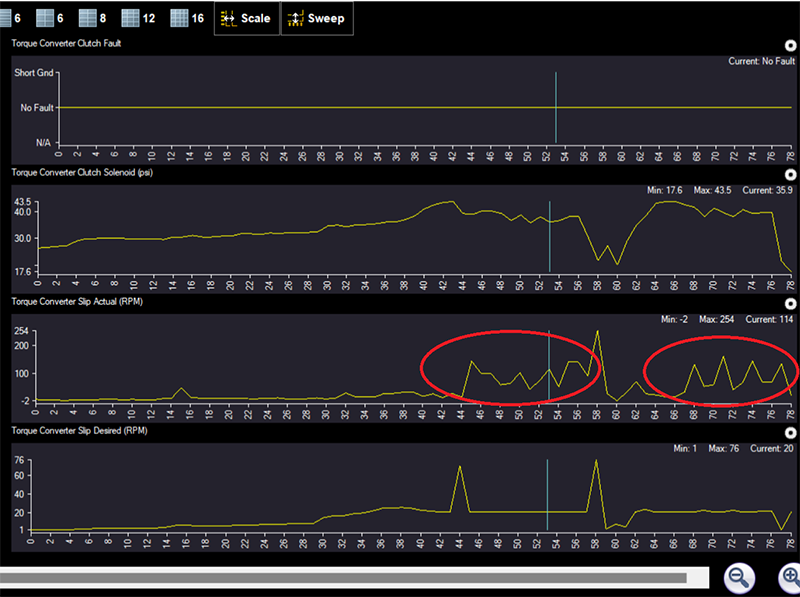About a month ago we received a 2015 Ford Expedition 4WD at the shop. It was equipped with a 3.5L Turbo V6 engine and a 6R80 transmission. The complaint read, "RPMs fluctuate up and down and there is a whirring noise." The vehicle was brought to us by one of our wholesale shops which had just installed one of our remanufactured units. It had been installed to correct a torque converter clutch shudder.
This is the first time we had seen the vehicle, so the first order of business was to verify the concern and scan for codes. There were no codes relating to the engine, transmission, or transfer case. The transmission fluid was full and appeared to be new and clean. I also checked the fluids in the engine, transfer case and both differentials which were all full and in average condition. A quick tire stagger check showed 1/4" of stagger, which is not enough to require any immediate attention or concern.
During the initial test drive I was able to verify an intermittent slight whirring noise from under the hood; this would intermittently happen with medium to heavy acceleration around 30 to 40 mph. I was also able to verify a slipping torque converter clutch on the scanner and an RPM fluctuation at the same time. This would happen with moderate acceleration on uphill inclines at highway speeds. The whirring sound was difficult to pinpoint since it was only for a short time and would not always happen. (Figure 1)

Figure 1
It is Certified Transmission's policy to always perform a hot plate test with the transmission fluid to verify that there is no coolant or water in it due to a ruptured radiator cooler, which can cause many repeat failures. After verifying that there was not any coolant or water contamination, a warranty claim was started for the torque converter clutch slip and RPM fluctuation. Our warranty department quickly decided to replace the transmission.
We replaced the transmission and thoroughly flushed the transmission coolers with a hot flush machine. I then reprogrammed the Powertrain Control Module (PCM) with the updated software from Ford, installed the correct solenoid strategy and solenoid body ID, cleared the Keep Alive Memory (KAM) and transmission adapts, then resumed adaptive learning just to be sure the PCM was starting over fresh as if it was new from the factory.
Well, unfortunately nothing changed with the warranty replacement transmission. It still had the same torque converter clutch slip on the scanner and the same RPM fluctuation. At this point, I got our lead diagnostician involved. He looked over the vehicle a little closer and noticed that it had been previously wrecked and found a broken ground wire inside the right front fender and some battery corrosion. (Figure 2)

Figure 2
After repairing the bad ground and cleaning the battery terminals we thought for sure this would fix it, yet again, it still had all the same symptoms. Another consultation with the warranty department was in order. They advised us to try a different torque converter with a different type of clutch material we had been testing.
While we were replacing the torque converter with the updated version, we found that one of the turbo intercooler duct tubes was loose and had a hole worn through it from rubbing on the crankshaft pulley. Could this possibly be the cause due to airflow disruption? When I saw this, I wanted to simply replace the tube and verify this as the root cause. However, the unit was already removed, so I elected to continue with the torque converter replacement. I was confident that the issue was not inside the transmission.
I was really hoping to find something outside of the transmission that was causing these symptoms. I began to wonder if the intermittent whirring sound had something to do with it. It didn't occur very often, so it was a matter of luck that I would even be able to duplicate it. I also wondered if I could duplicate the noise with the vehicle standing still by stalling the torque converter (power–braking). I heavily stalled the torque converter briefly, and lo and behold the whirring noise was heard and the RPMs even fluctuated just like it did on the highway. In the following figure I was NOT moving, but the actual TCC slip was surging in a very similar fashion. (Figure 3)

Figure 3
Here is the real kicker: the check engine light popped on and set a P0234 Turbo Boost Pressure code for the first time. A Technical Service Bulletin (TSB) search of this code revealed TSB #16–0013 addressing a problem with the actual turbocharger possibly needing to be replaced. It also described the code being associated with similar symptoms we were having. It stated drivability symptoms may include surging or noises which may be described as an air rush, hiss, whoosh, whistle, grinding, growling, or scraping. Could this have been the whole issue all along? I still cannot wrap my head around why the scan data showed a TCC slip if it was just an engine surge that was causing all of it.
We then turned the vehicle over to the wholesale shop that originally replaced the shuddering transmission. They did engine performance repairs, so we waited to hear from them about whether this TSB repair procedure took care of these symptoms or not.
The shop notified us that all the symptoms were resolved after replacing the left turbocharger assembly. I wanted to drive the vehicle again and take additional scanner recordings, but the vehicle had already been released back to the customer. There was a lot of cause and effect at play in this case.
 Certified Transmission
Certified Transmission
